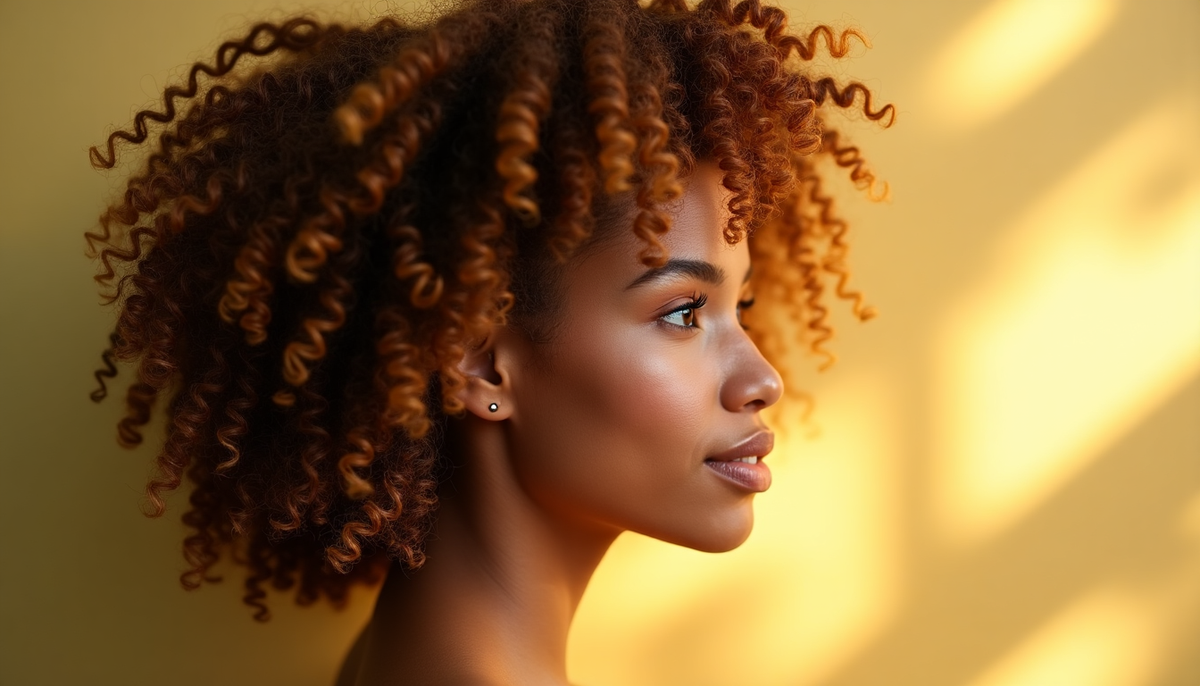

Have you noticed your scalp feeling tight, itchy, or uncomfortable after weeks of continuous styling? Your hair might be sending you an important message - it needs to breathe. Like your skin, your scalp requires proper air circulation to maintain health and promote optimal hair growth.
Knowing when and how long to let your natural hair breathe between styles is crucial for maintaining healthy locks, whether you're a fan of protective styles or regularly use heavy hair products. This is especially important if you frequently wear braids or other tight hairstyles that can stress your scalp and hair follicles.
In this article, we'll explore why letting your natural hair breathe is vital for your hair's health. You'll discover the science behind scalp oxygenation, learn to recognize warning signs of suffocation, and understand proven techniques for maintaining optimal hair health.
Table of Contents
Understanding Hair and Scalp Oxygenation
Your scalp houses over one million hair follicles, each requiring proper oxygen to function optimally. These tiny but mighty structures aren't just passive holes in your skin - they're complex biological factories that need constant nourishment to produce healthy, natural hair.
The Science Behind Hair Follicle Breathing
Your hair follicles exist in the top two layers of your skin, which need oxygen for vital cellular processes. Think of your follicles as tiny plants - just as plants need air to grow, your hair needs oxygen to thrive. These follicles don't just grow hair; they also help repair your skin and form new blood vessels.
How Product Buildup Affects Scalp Health
When you continuously use hair products without proper cleansing, they can create a barrier on your scalp. This buildup combines natural oils, dead skin cells, and styling products that can clog your follicles. The consequences of this buildup can be serious:
Inflammation of hair follicles
Crusty sores that resist healing
Potential permanent hair loss
Bacterial growth on the scalp
Impact of Oxygen on Hair Growth Cycles
A sufficient oxygen supply maintains a healthy scalp and encourages hair growth. When your follicles receive adequate oxygen, they can better support the hair growth cycle, including growth, regression, and rest phases. Research shows that oxygen deficiency can significantly slow down hair growth, with studies demonstrating that increasing oxygen levels can enhance human hair organ elongation up to four times compared to oxygen-deprived conditions.
Your hair's growth cycle typically lasts two to eight years, but this can be shortened when your follicles don't get enough oxygen. That's why letting your natural hair breathe between protective styles and heavy product use is crucial.
Health Benefits of Hair Breathing
Letting your natural hair breathe regularly creates a powerful ripple effect that benefits your scalp and hair health. When you take breaks between protective styles, you're not just giving your scalp a rest - you're actively promoting better hair growth conditions.
Improved Blood Circulation to Follicles
Freeing your hair from tight styles and heavy products enhances blood flow to your scalp. This increased circulation delivers vital oxygen to your hair follicles, promoting better growth and strength. Think of it as giving your scalp a breath of fresh air - the improved blood flow helps rejuvenate sluggish hair follicles and supports healthy hair development.
Enhanced Nutrient Absorption
Your scalp becomes more receptive to nourishing ingredients when it's allowed to breathe. Here's what happens when you give your hair regular breaks:
Better absorption of essential nutrients like iron and zinc
Improved uptake of omega-3 fatty acids that benefit scalp health
Enhanced vitamin C absorption, which aids iron uptake for stronger hair
Prevention of Bacterial Growth
A well-ventilated scalp creates an environment that discourages harmful bacterial growth. When you let your hair breathe between styles, you're helping prevent common scalp issues like:
Bacterial buildup: Regular breaks help prevent folliculitis and other bacterial infections that can damage your hair follicles. By maintaining proper scalp ventilation, you create conditions that support natural bacterial balance and prevent unwanted growth.
Remember that your scalp needs these breathing periods to maintain its natural balance. Just as you wouldn't wear a tight shoe all day, every day, your scalp needs breaks from constant styling to function at its best.
Signs Your Hair Needs to Breathe
Recognizing when your hair needs a break is crucial for maintaining healthy locks. Your scalp and hair will often send clear signals when they're crying out for some breathing room.
Common Symptoms of Suffocated Scalp
Your scalp might tell you it needs air if you're experiencing persistent itching, burning, or unusual bumps. Watch out for these warning signs that indicate your scalp needs to breathe:
Extreme oiliness or dandruff
Scalp redness and sensitivity
Unexplained hair loss
Scalp pain or discomfort
Bacterial growth on the scalp
Warning Signs of Product Buildup
When your natural hair starts feeling waxy or heavy, even after washing, it's likely suffering from product buildup. Pay attention if your hair appears darker than usual or feels piece-y, as these are telltale signs of excessive product accumulation. Your hair might also become suspiciously resistant to holding its natural texture.
When to Take a Styling Break
If you regularly wear protective styles like braids or weaves, it's recommended to let your hair breathe for 1-2 weeks between installations. For those using heavy styling products, consider taking a three-day break when you notice your hair becoming flat, frizzy, or unruly. This break allows your scalp to reset and helps prevent potential long-term damage.
Remember that prolonged buildup can lead to clogged follicles and even permanent hair loss if left untreated. If you notice your roots getting greasy quickly or your hair looking increasingly dull, it's time to give your tresses a much-needed breathing period.
Scientific Methods for Hair Recovery
Modern science offers several proven methods to help your natural hair recover from styling stress and product buildup. Recent research has unveiled effective techniques that can restore your scalp's natural balance and promote healthy hair growth.
Scalp Detoxification Techniques
When your scalp needs revival, a proper detox can work wonders. Clinical studies show that bentonite clay and apple cider vinegar combinations effectively remove buildup while maintaining scalp health. For optimal results, combine these natural ingredients with aloe vera gel, which contains proteolytic enzymes that help repair dead skin cells on the scalp.
Proper Ventilation Practices
Your scalp's health depends significantly on proper ventilation. Research indicates that taking breaks between protective styles allows for better oxygen flow to hair follicles. Key practices include:
Using clarifying treatments every four weeks
Implementing gentle exfoliating cleansers to dissolve buildup
Allowing 1-2 weeks between protective-style installations
Research-Backed Treatment Options
Modern medicine offers several scientifically proven solutions for hair recovery. FDA-approved treatments have shown remarkable results in clinical trials:
Low-level laser therapy (LLLT) has demonstrated significant benefits, with studies showing improved hair density in 69% of participants with androgenetic alopecia. Additionally, microneedling therapy has emerged as an effective treatment, creating microchannels that enhance drug absorption and activate hair growth-related genes.
For more severe cases, medical professionals might recommend JAK inhibitors, which have shown promise in reawakening dormant hair follicles. These treatments work by blocking specific molecular signals that can inhibit hair growth, offering new hope for those struggling with significant hair loss.
Conclusion
Your hair's health depends significantly on proper breathing periods between styles and treatments. Understanding the signs of scalp suffocation and implementing regular breaks can prevent long-term damage while promoting optimal hair growth conditions.
Scientific evidence shows that oxygen-rich environments support healthier hair follicles and stronger growth cycles. Making time for your scalp to breathe isn't just a beauty trend - it's a scientifically-backed necessity for maintaining vibrant, healthy hair.
Remember to watch for warning signs like persistent itching, unusual buildup, or scalp discomfort. These signals indicate your hair needs a break from heavy styling or products. Schedule regular 1-2 week breathing periods between protective styles, and consider incorporating proven treatments like clarifying masks or gentle exfoliation when needed.
Your scalp's health directly impacts your hair's appearance, strength, and growth potential. Changes in your hair care routine today can lead to significantly healthier locks tomorrow. Start paying attention to your scalp's needs, and you'll notice the difference in your hair's overall health and appearance.
Frequently Asked Questions
Why is it important to let your hair breathe between protective styles?
Letting your hair breathe between protective styles is crucial for maintaining scalp health, preventing product buildup, and allowing hair follicles to receive proper oxygenation. This break helps reduce the risk of scalp irritation, bacterial growth, and potential hair loss from prolonged tension on the roots.
How often should you give your hair a break from protective styling?
Giving your hair a 1-2 week break between protective styles is generally recommended. This allows time for your scalp to recover, enables you to assess your hair's condition, and provides an opportunity for deep conditioning and necessary treatments.
What are the signs that your hair needs to breathe?
Signs that your hair needs a break include persistent itching or scalp discomfort, unusual bumps, extreme oiliness or dandruff, scalp redness, unexplained hair loss, and hair feeling waxy or heavy even after washing. If you notice these symptoms, it's time to let your hair breathe.
Can letting your hair breathe improve its growth?
Yes, allowing your hair to breathe can improve growth. When your scalp has proper ventilation, it enhances blood circulation to the follicles, promoting better nutrient absorption and supporting healthier hair growth cycles. This can lead to stronger, more vibrant hair over time.
What are some effective ways to help your hair recover after prolonged protective styling?
To help your hair recover, try scalp detoxification techniques using natural ingredients like bentonite clay or apple cider vinegar. Implement gentle cleansing and exfoliating practices, and consider treatments like low-level laser therapy or microneedling under professional guidance. Always prioritize moisturizing and gentle handling during this recovery period.




